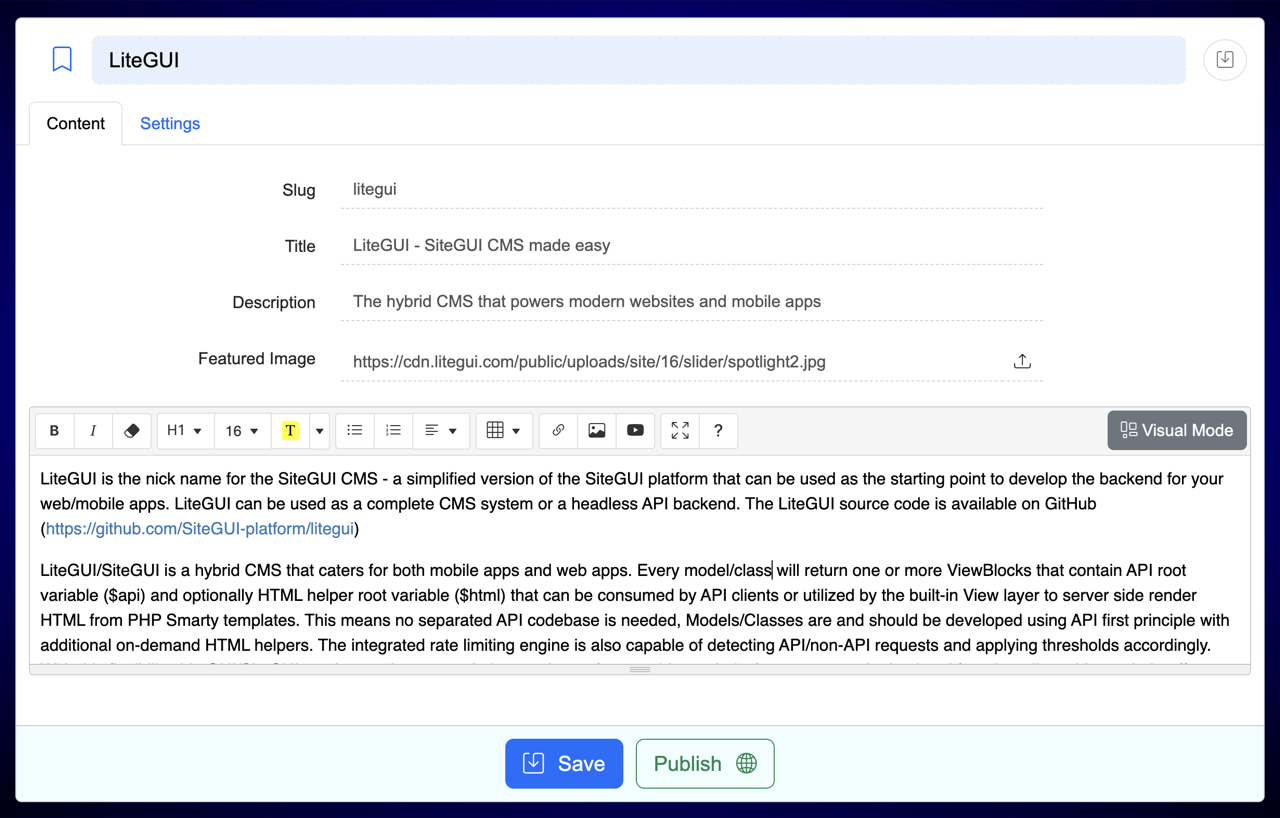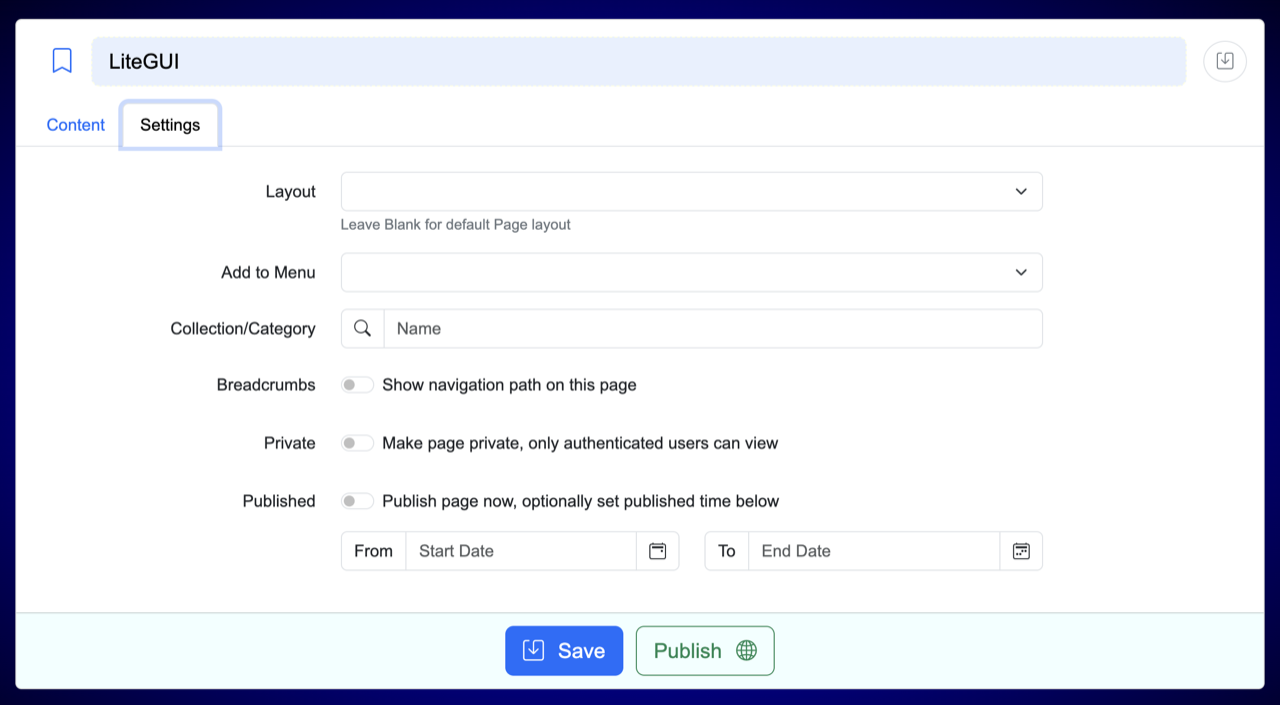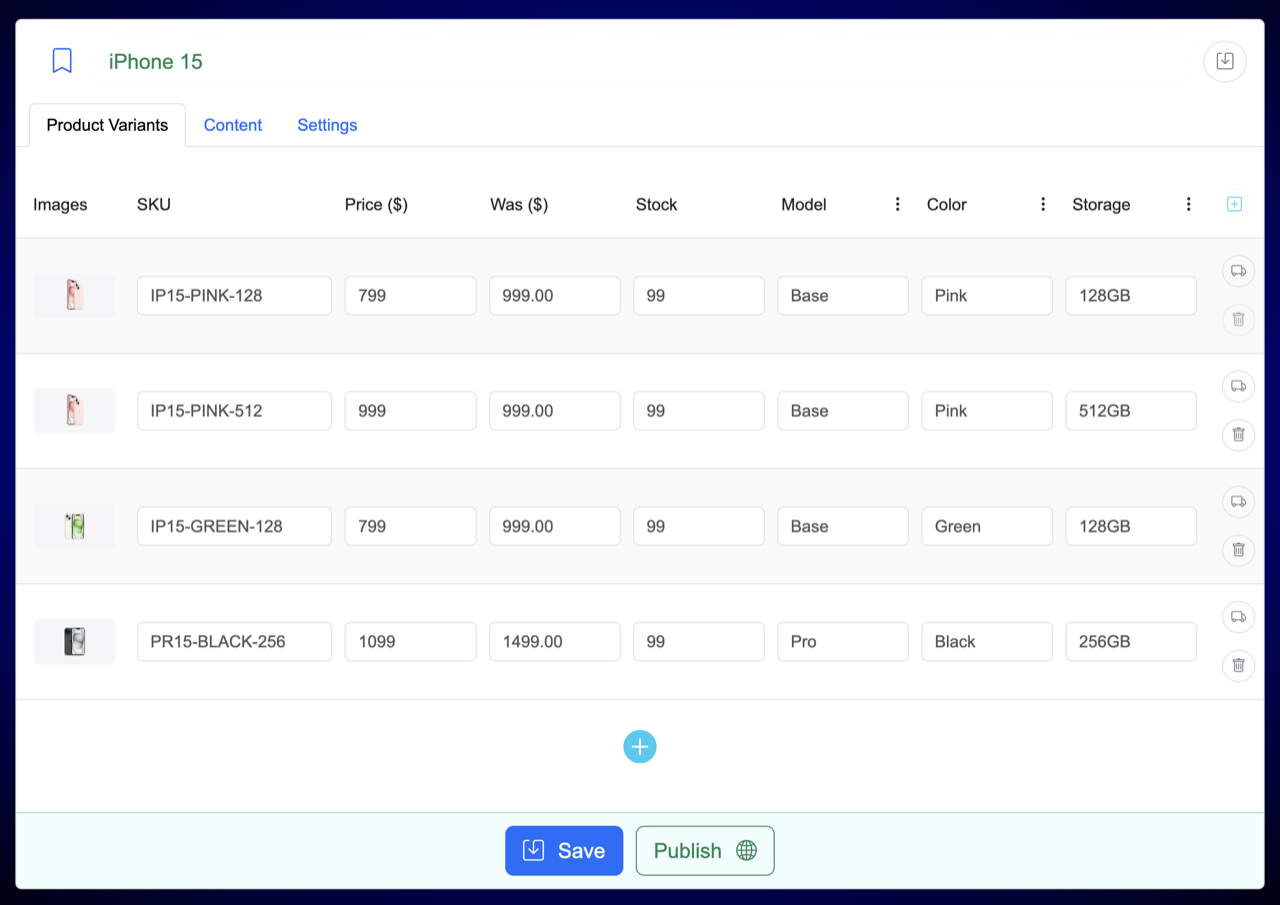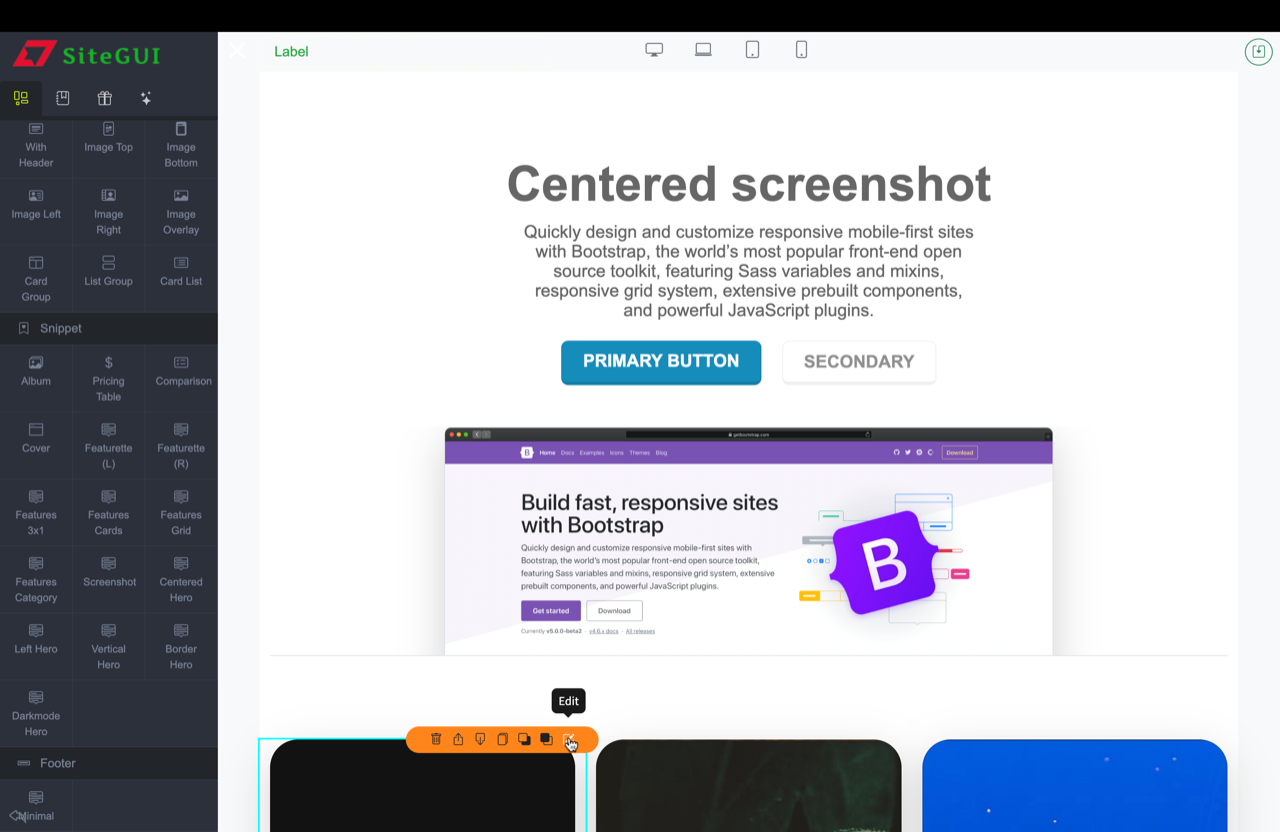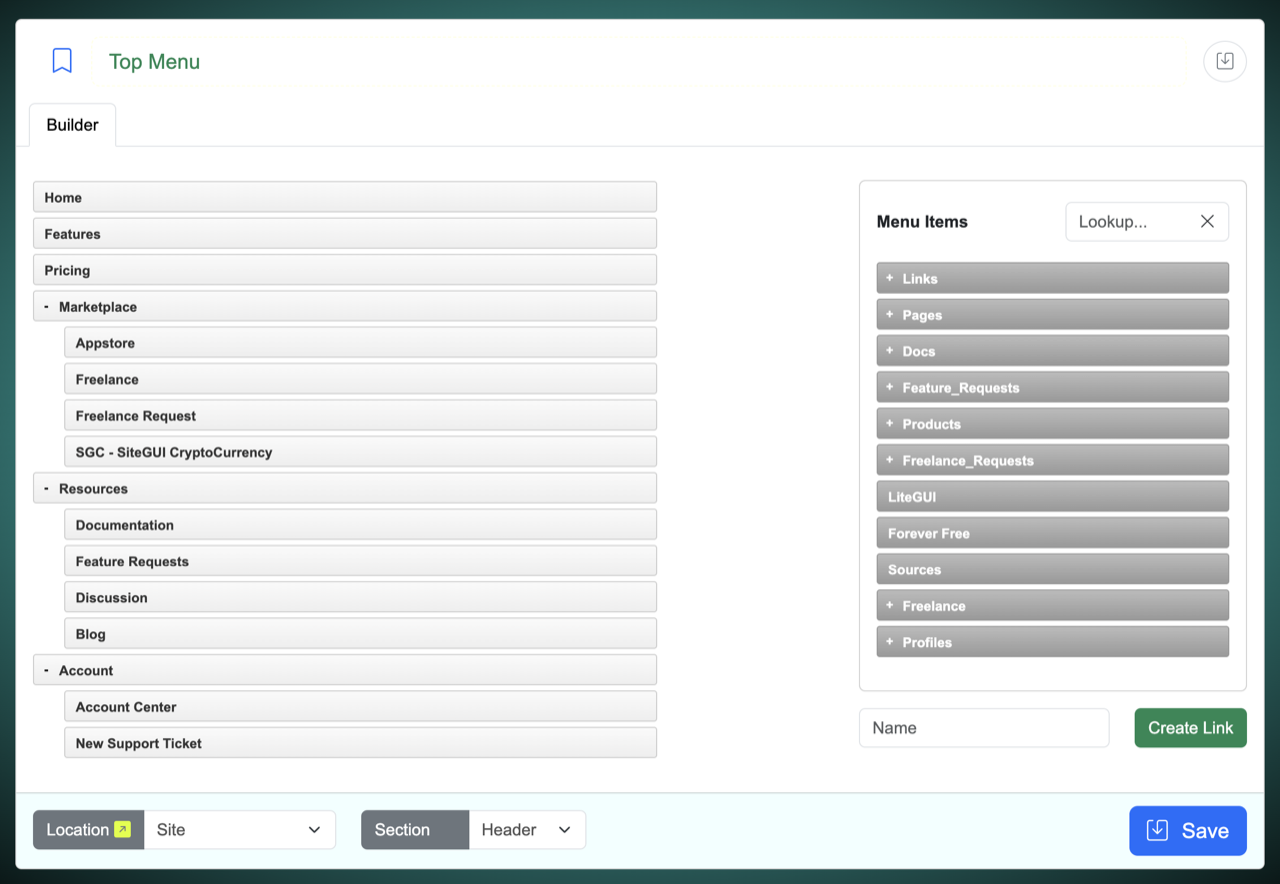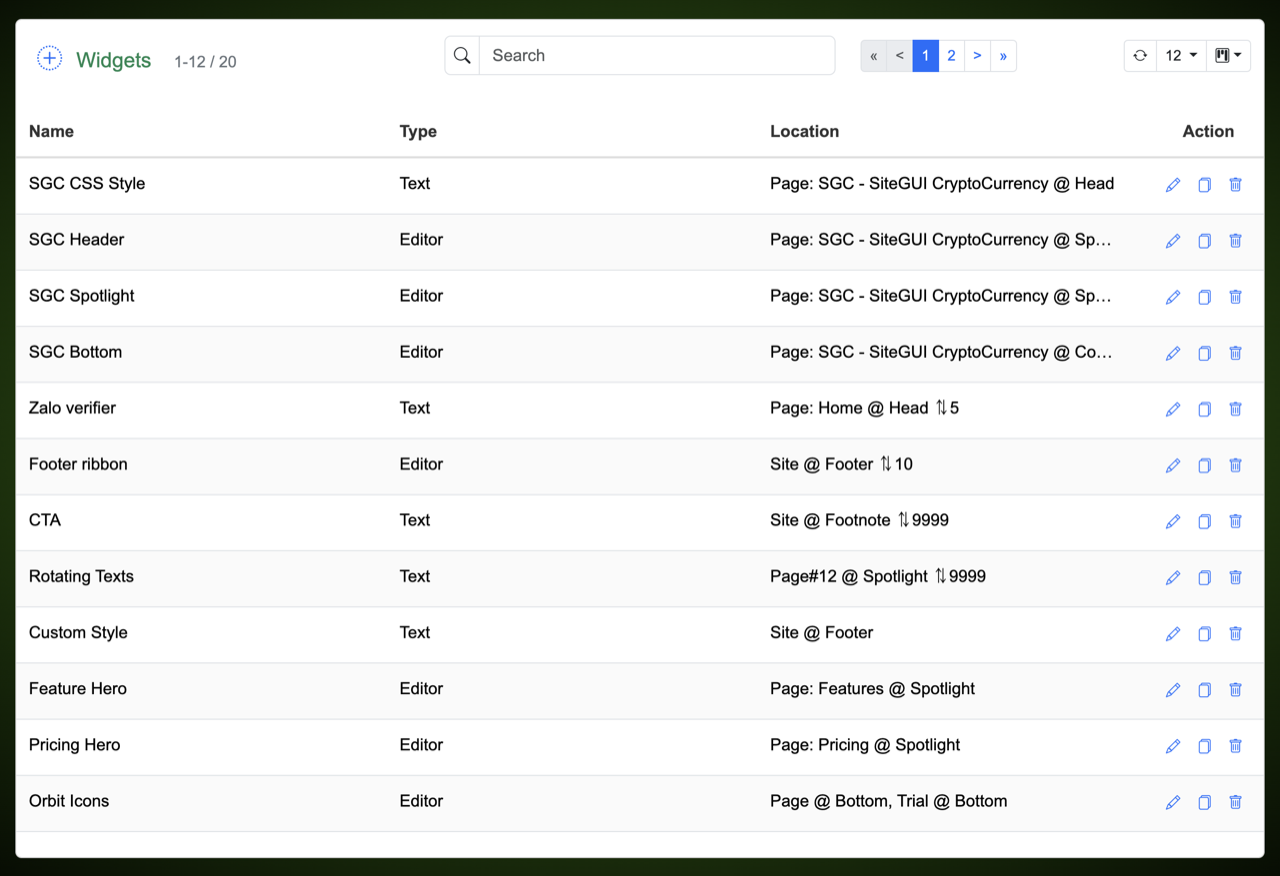SiteGUi CMS aka LiteGUi
LiteGUi is the nick name for the SiteGUi CMS - a simplified version of the SiteGUi platform that can be used as a starting point to develop the backend for your web/mobile apps. LiteGUi can be used as a complete CMS system or a headless API backend.
LiteGUI/SiteGUI Differences
LiteGUI/SiteGUI is a hybrid CMS that caters for both mobile apps and web apps. Every Model/Class will return one or more ViewBlocks that contain API root variable ($api) and optionally HTML helper root variable ($html) that can be consumed by API clients or utilized by the built-in View layer to render HTML from PHP Smarty templates server side. This means no separated API codebase is needed, Models/Classes are and should be developed using API first principle with additional on-demand HTML helpers. The integrated rate limiting engine is also capable of detecting API/non-API requests and applying thresholds accordingly. With this flexibility, LiteGUI/SiteGUI can be used as a stand-alone web app (server side rendering) or serves as the backend for other client side rendering (front-end) frameworks (NextJS, ReactJS etc) and mobile apps.
LiteGUI/SiteGUI is also the first CMS that employs sub-domains/sandboxing for mitigating XSS attacks. As LiteGUI/SiteGUI supports 3rd-party templates/themes, this mitigation strategy helps protect site owners from all types of XSS attacks (stored, reflected or DOM-based) that may (accidentally) be brought into their sites from 3rd party templates/themes. LiteGUI/SiteGUI uses a dedicated sub-domain for managing/submitting sensitive data and another sub-domain (loaded in a frame) for managing arbitrary contents and widgets (sandboxing). The advantage of sandboxing is that LiteGUI/SiteGUI can accept raw HTML content produced by a WYSIWYG editor or even through the browser's developer console, there is no need to use non-HTML editor like Markdown for editing the content. The main domain can display arbitrary contents (produced by site editors) as sensitive write operations are limited on the main domain. Despite using different sub-domains to avoid sharing cookies/authentication, the transitions/experience are seamless as LiteGUI/SiteGUI employs resource-based time-constraint token to automatically pass authenticated user information between sub-domains.
Features
LiteGUI includes the following features:
- User and Staff Portal (Social/Oauth Login optional)
- Staff & Role RBAC Management
- User Management
- User Group Management
- Headless/API backend
- Pre-made and Custom Apps/Templates (available on SiteGUI Appstore)
- CMS
- Multilingual
- Visual Editor with Drag and Drop support
- Widget Editor to attach Widget content to any predefined layout section
- Menu Editor
- File Manager
- Template & Layout Editor
- Custom Layout
- Template Inheritance
- Page Cloning
- Page Versioning
- Product Editor
- Multiple Product Variants
- Multiple Product Attributes
License
LiteGUI is distributed under the Elastic License 2.0 (https://www.elastic.co/licensing/elastic-license) that allows using the software for almost any purpose (e.g: build a web/mobile application for your customer using LiteGUI and charge an one-off fee for the development service) except providing/hosting the software as a cloud/SaaS product (for which customers are charged on a recurring basis).
LiteGUI free/default themes/templates are distributed under the MIT License.
Installation
LiteGUI requires PHP 8 (with Curl, GD, Mbstring, MySQL, Redis and XML extensions), MySQL/MariaDB, Nginx web server and optionally Redis to work properly.
LiteGUI provides pre-configured virtual machine images that can be deployed on your own server or public cloud providers. This is the preferred installation method as LiteGUI has been configured to work out of the box. We also provide a setup.sh script to set your domain up with LiteGUI when you login as root via virtual console (the root password is StartLiteGUI) or SSH using a public key.
The following images are available. Please note that all files are compressed and are about 750MB in size, the listed size is the maximum capacity for the virtual hard drive. You may use the 25G drive for testing and the 50G drive for production, this capacity can be increased if you need more storage space.
The best way to spin up these images and have your LiteGUI environment ready in minutes is to sign up for a LiteGUI VM through SiteGUI, the minimal VM starts from $10/month. You can also download the 25G QEMU image and upload to cloud providers like DigitalOcean to create a LiteGUI VM from the image. DigitalOcean offers free $200 credit (valid for 60 days) for you to try out, here is the signup link https://m.do.co/c/5f276041432e.
For those who wants to install LiteGUI manually on an existing server, you may download the source here and place it outside the webroot (to prevent direct access) and then configure Nginx to serve your website using mysite/src/index.php, the user portal using mysite/src/siteuser.php, the staff portal using mysite/src/siteadmin.php and the static files using the folder mysite/resources/public (see the sample Nginx configuration below). You also need to create a database to load the schema and data provided in the file "sitegui_mysite.sql". After that you can add the database connection credentials and domain information to mysite/src/config.php or config.local.php to complete the installation.
server {
listen 80;
listen 443 ssl;
http2 on;
server_name litegui.com *.litegui.com editing.domain.com;
include ssl_params;
ssl_certificate ssl/litegui.com.crt;
ssl_certificate_key ssl/litegui.com.key;
# SiteIndex
location / {
include fastcgi_params;
fastcgi_pass unix:/var/run/php/php8.3-fpm.sock;
fastcgi_param SCRIPT_FILENAME /home/sitegui/mysite/src/index.php;
fastcgi_param SERVER_NAME $host;
}
# SiteAdmin
location ~ ^/siteadmin/oauth/ {
rewrite ^/siteadmin/oauth/(.+) /siteadmin?oauth=$1 permanent;
}
location ~ ^/siteadmin(/|\.json|$) {
include fastcgi_params;
fastcgi_pass unix:/var/run/php/php8.3-fpm.sock;
fastcgi_param SCRIPT_FILENAME /home/sitegui/mysite/src/siteadmin.php;
fastcgi_param SERVER_NAME $host;
}
# SiteUser
location ~ ^/account/oauth/ {
rewrite ^/account/oauth/(.+) /account?oauth=$1 permanent;
}
location ~ ^/account(/|\.json|$) {
include fastcgi_params;
fastcgi_pass unix:/var/run/php/php8.3-fpm.sock;
fastcgi_param SCRIPT_FILENAME /home/sitegui/mysite/src/siteuser.php;
fastcgi_param SERVER_NAME $host;
}
location ~ [^/]\.php(/|$) {
deny all; #no need to serve any PHP files other than the above
}
}
#Serving images/assets files
server {
listen 80;
listen 443 ssl;
http2 on;
server_name cdn.litegui.com;
#root /home/sitegui/public_html;
include ssl_params;
ssl_certificate ssl/litegui.com.crt;
ssl_certificate_key ssl/litegui.com.key;
# Disable access to .php and .tpl files completely
location ~ \.(php|tpl)$ {
return 403;
}
location /public/ {
root /home/sitegui/mysite/resources; # /public/ will be added automatically
location ~ \.(json)$ {
add_header Access-Control-Allow-Origin *; #allow cors for on demand translation
}
}
# SiteIndex
location / {
try_files $uri $uri/ =404;
}
}
